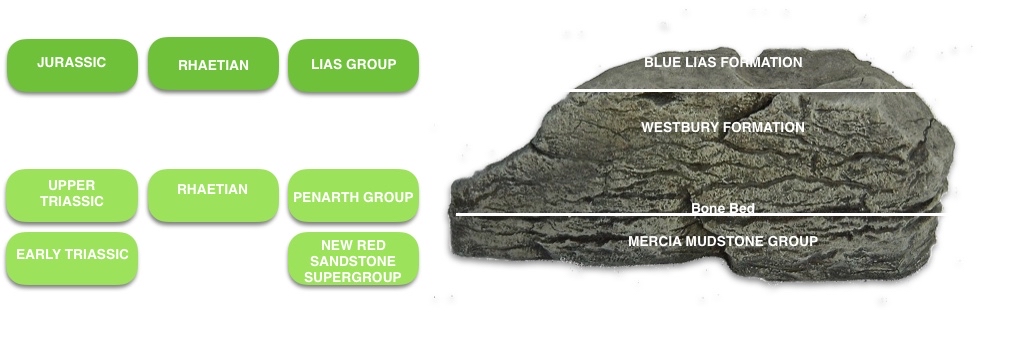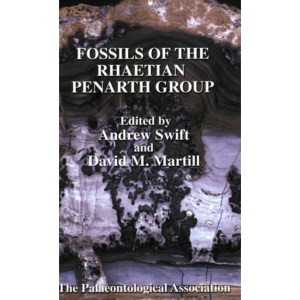Further up the River Severn from the other classic sites, such as Aust and Hock Cliff, Westbury-on-Severn (also known as Garden Cliff) is one of the finest localities for collecting from the famous Rhaetian- aged bone bed from the Penarth Group. Out of all of the localities along the Severn, this has the most rapid erosion.
DIRECTIONS
♦ The A48 runs through Westbury-on-Severn. If coming from the west, after passing a church, at the next crossroads, take the right hand road. If coming from the east, just before the main village centre, you will see a crossroads. Take the road on the left.
♦ The road will come to a junction, where you should turn right. This is all Strand Lane. Once you reach the end of this road, you will come to the river wall. There is a private road running alongside the river, but do not go down this road. Instead, there should be space for one car just before this road, ensuring that you do not block the entrance to the private road.
♦ If parking is not available here, you will need to drive back to the top of Strand Road and walk back down. The cliffs are just the other side of the wall on the left.
♦ Ref: 51.81699°N, 2.41453°W
PROFILE INFO
FIND FREQUENCY: ♦♦♦♦ – Fossils at this location are very common, although the best from the bone bed are rare as a result of over collecting. The rapid erosion here creates a regular supply of material to search through.
CHILDREN: ♦♦ -This location is not suitable for children. The high winds cause the beach to become steep with scree, and you can easily slip down into the river.
ACCESS: ♦♦♦♦ – Parking can sometimes be found at the bottom of Strand Lane, providing you do not park on the private road and do not block access. Here, the cliff is immediately the other side of the road. The alternative is to park at the top of Strand Road and walk down.
TYPE: – This is a site of special scientific interest (SSSI). You can only collect loose fossils from the foreshore. The best area is at the far end of the cliff, where the beds dip to the base of the cliff, but hammering or collecting from the bedrock is not permitted.
FOSSIL HUNTING
When you first enter the beach at Westbury-on-Severn, the cliffs mostly consists of the Mercia Mudstone Group, with interbedded red and green strata. In part of the cliff that you will notice the beds start dipping quite rapidly. At the very end of the cliff, the Rhaetian beds of the Westbury Formation reach the base of the cliff, unlike at Aust, where they are far too high to study.
Westbury-on-Severn has some of the finest exposures of the Rhaetian Penarth beds and it is for this reason they were named the Westbury Formation, a fossiliferous.
Head towards the end of the cliff, where you will see plenty of blocks on the foreshore. If you look carefully at the majority of the fallen slabs here, you will notice they have ripple marks with pockets of bones. The blocks will reveal fish scales and fragments of bone. Within this ‘Pullastra Bed’ there seems to be a few fish and shark teeth. The best bones are found in the layer on top of this bed.
There are also two bone beds, on one of which is a yellowish, orange highly pyritic hard layer; and there is a second hard layer with pockets of yellowish orange sand, which also contains bones. It is these thin layers that are highly productive. Ichthyosaur remains are more common here than at Aust. You can also find coprolites, fish remains and the bones of other reptiles.
As this site is a SSSI, you can only collect loose fossils from the foreshore. Hammering the bedrock and collecting any in situ fossils are not permitted by law. You must respect this scientific important site.


GEOLOGY
The first section of the cliffs is Triassic Mercia Mudstone Formation, which is unfossiliferous. The high and regular winds cause the mudstone to flake off and fall to the ground, giving rise to very steep scree slopes.
Once you reach the middle part of the cliffs, you will see the Rhaetic-aged beds of the Westbury Formation, which dip to beach level at the very end of the cliff. At the top of these is a thin layer of Jurassic Lower Lias.


SAFETY
Garden Cliff at Westbury-on-Severn is the fastest eroding cliff along the River Severn. The river regularly reaches the base of the cliff, so you can easily get cut off. Also, the steep angle of scree makes the beach quite slippery, especially at the end with the mudflats. Take extra care. The cliffs are crumbling all the time, so keep well away from the cliff face.
EQUIPMENT
This is a SSSI. Collecting is allowed, but hammering the bedrock is not permitted. Therefore, you only need appropriate footwear and bags to carry your finds.
ACCESS RIGHTS
Under no circumstances should hammers be used on any in situ material in the cliff face.
It is important to follow our ‘Code of Conduct’ when collecting fossils or visiting any site. Please also read our ‘Terms and Conditions‘
LINKS
♦ Buy Fossils, Crystals, Tools
♦ Location Discussions
♦ Deposits Magazine
♦ Join Fossil Hunts
♦ UK Fossils Network






























